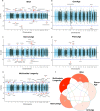Multi-omic underpinnings of epigenetic aging and human longevity
- PMID: 37076473
- PMCID: PMC10115892
- DOI: 10.1038/s41467-023-37729-w
Multi-omic underpinnings of epigenetic aging and human longevity
Abstract
Biological aging is accompanied by increasing morbidity, mortality, and healthcare costs; however, its molecular mechanisms are poorly understood. Here, we use multi-omic methods to integrate genomic, transcriptomic, and metabolomic data and identify biological associations with four measures of epigenetic age acceleration and a human longevity phenotype comprising healthspan, lifespan, and exceptional longevity (multivariate longevity). Using transcriptomic imputation, fine-mapping, and conditional analysis, we identify 22 high confidence associations with epigenetic age acceleration and seven with multivariate longevity. FLOT1, KPNA4, and TMX2 are novel, high confidence genes associated with epigenetic age acceleration. In parallel, cis-instrument Mendelian randomization of the druggable genome associates TPMT and NHLRC1 with epigenetic aging, supporting transcriptomic imputation findings. Metabolomics Mendelian randomization identifies a negative effect of non-high-density lipoprotein cholesterol and associated lipoproteins on multivariate longevity, but not epigenetic age acceleration. Finally, cell-type enrichment analysis implicates immune cells and precursors in epigenetic age acceleration and, more modestly, multivariate longevity. Follow-up Mendelian randomization of immune cell traits suggests lymphocyte subpopulations and lymphocytic surface molecules affect multivariate longevity and epigenetic age acceleration. Our results highlight druggable targets and biological pathways involved in aging and facilitate multi-omic comparisons of epigenetic clocks and human longevity.
© 2023. This is a U.S. Government work and not under copyright protection in the US; foreign copyright protection may apply.
Conflict of interest statement
The authors declare no competing interests.
Figures




References
Publication types
MeSH terms
Substances
Grants and funding
LinkOut - more resources
Full Text Sources

